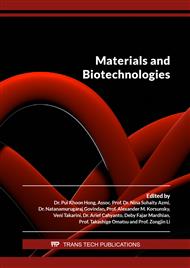[1]
Pulpdent Corporation. Activa Bioactive Overview [Internet]. 2019. Available from: https://www.pulpdent.com/activa-bioactive-overview/.
Google Scholar
[2]
D.P. Antunes, R. Marques, D.M. Marinho, M. Carneiro, V. Garakis. Buffer Capacity of Saliva as a Function of Time after Consumption of Sugary, Sugar-Free and Probiotic Chewing Gums. Brazilian Res Pediatr Dent Integr Clin. 15 (2015):153–61.
DOI: 10.4034/pboci.2015.151.17
Google Scholar
[3]
I. Nedeljkovic, J.D. Munck, V. Slomka, B. Van Meerbeek, W. Teughels, K.L. Van Landuyt. Lack of Buffering by Composites Promotes Shift to More Cariogenic Bacteria. J Dent Res. 95 (2016):875–81.
DOI: 10.1177/0022034516647677
Google Scholar
[4]
S.K. Sidhu, J.W. Nicholson. A Review of Glass-Ionomer Cements for Clinical Dentistry. J Funct Biomater. 7 (2016):16.
Google Scholar
[5]
M. Fuss, J. Wicht, T. Attin, H.M. Derman, M.J. Noack. Protective Buffering Capacity of Restorative Dental Materials In Vitro. J Adhes Dent. 19 (2017):177–83.
Google Scholar
[6]
J.L. Moreau, H.H.K. Xu. Fluoride Releasing Restorative Materials: Effects of pH on Mechanical Properties and Ion Release. Dent Mater. 26 (2010):e227-35.
DOI: 10.1016/j.dental.2010.07.004
Google Scholar
[7]
N. Gupta, S. Jaiswal, P. Bansal. Comparison of Fluoride Ion Release and Alkalizing Potential of A New Bulk-Fill Alkasite. J Conserv Dent. 22 (2019):296–9.
DOI: 10.4103/jcd.jcd_74_19
Google Scholar
[8]
Y. Wang, M. Kaga, D. Kajiwara, H. Minamikawa, S. Kakuda, M. Hashimoto. Ion Release and Buffering Capacity of S-PRG Filler-containing Pit and Fissure Sealant in Lactic Acid. Nano Biomed. 3 (2011):275–81.
Google Scholar
[9]
A. Asali. Fluoride Release, pH change and Recharge Ability of Different Types of Glass Ionomer Restorative Materials: A Comparative In-Vitro Study. ProQuest Dissertations and Thesis. (2016).
Google Scholar
[10]
S. Krishnamurthy, J. Narasimhan, R.B. Nammalwar. The Effect of Capsulated Glass Ionomer Cements on The pH of a Lactic Acid Solution: An In-Vitro Study. J Clin Diagnostic Res. 6 (2012):316–8.
Google Scholar
[11]
S. Tiwari, M. Kenchappa, D. Bhayya, S. Gupta, S. Saxena, S. Satyarth. Antibacterial Activity and Fluoride Release of Glass-Ionomer Cement, Compomer and Zirconia Reinforced Glass-Ionomer Cement. J Clin Diagnostic Res. 10 (2016):ZC90–3.
DOI: 10.7860/jcdr/2016/16282.7676
Google Scholar
[12]
S. Virmani, M. Hegde, S. Shetty, V. Sadananda. Comparative Evaluation of Fluoride Release from Three Glass Ionomer Cements – An in vitro Study. Br J Appl Sci Technol. 18 (2016):1–6.
DOI: 10.9734/bjast/2016/26398
Google Scholar
[13]
M. Buzalaf. Fluoride and the Oral Environment. Monogr Oral Sci, Basel, Karger. 22 (2011):97–114.
Google Scholar
[14]
G.J. Mount, W.R. Hume, H.C. Ngo, M.S. Wolff. Preservation and Restoration of Tooth Structure. 3rd Ed. Wiley Blackwell; 2016, p.44.
Google Scholar
[15]
S. Baliga, S. Muglikar, R. Kale. Salivary pH: A diagnostic biomarker. J Indian Soc Periodontol. 17 (2013):461.
DOI: 10.4103/0972-124x.118317
Google Scholar
[16]
E. Korkut, O. Gezgin, F. Tulumbacı, H. Özer, Y. Şener. Comparative Evaluation of Mechanical Properties of a Bioactive Resin Modified Glass Ionomer Cement. EÜ Dişhek Fak Derg. 38 (2017):170-5.
DOI: 10.5505/eudfd.2017.38243
Google Scholar
[17]
T.N.A.T. Rahim, D. Mohamad, H.M. Akil, I.A. Rahman. Water sorption characteristics of restorative dental composites immersed in acidic drinks. Dent Mater. 28 (2012):e63-70.
DOI: 10.1016/j.dental.2012.03.011
Google Scholar
[18]
X. Xu, J.O. Burgess. Compressive strength, fluoride release and recharge of fluoride-releasing materials. Biomater. 24 (2003):2451-61.
DOI: 10.1016/s0142-9612(02)00638-5
Google Scholar
[19]
N. Abdulsamee, A.H. Elkhadem. Zirconomer and Zirconomer Improved (White Amalgams): Restorative Materials for the Future. Review. EC Dent Sci. 4 (2017):134–50.
Google Scholar
[20]
C.H. Phin, K. Shetty, K. Kunaparaju. Effect of Alcoholic Beverages on the Surface Microhardness of Three Restorative Materials. J Int Dent Med Res. 13 (2020):1268-75.
Google Scholar
[21]
A.A.R. Al-Shekhli, I.A. Aubi. Compressive Strength Evaluation of Giomer and Compomer Storage in Different Media. J Int Dent Med Res. 13 (2020):23-28.
Google Scholar
[22]
N.S.W.N. Hajira, N. Meena. GIOMER- The Intelligent Particle (New Generation Glass Ionomer Cement). Int J Dent Oral Health. 2 (2015):1-5.
DOI: 10.16966/2378-7090.166
Google Scholar
[23]
D. Jayaraj, E.P. Simon, M.R. Kumar. Cention-N: A Review. Dent Bites. 5 (2018):14-21.
Google Scholar
[24]
P. Poornima, P. Koley, M. Kenchappa, N.B. Nagaveni, K.P. Bharath, I.E. Neena. Comparative evaluation of compressive strength and surface microhardness of EQUIA Forte, resin‑modified glass‑ionomer cement with conventional glass‑ionomer cement. J Indian Soc Pedod Prev Dent. 37 (2019):265-70.
DOI: 10.4103/jisppd.jisppd_342_18
Google Scholar
[25]
C. Ruengrungsom, M.F. Burrow, P. Parashos, J.E.A. Palamara. Evaluation of F, Ca, and P release and microhardness of eleven ion-leaching restorative materials and the recharge efficacy using a new Ca/P containing fluoride varnish. J Dent. 102 (2020):1-12.
DOI: 10.1016/j.jdent.2020.103474
Google Scholar



